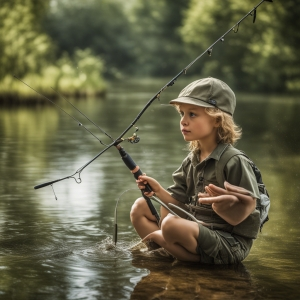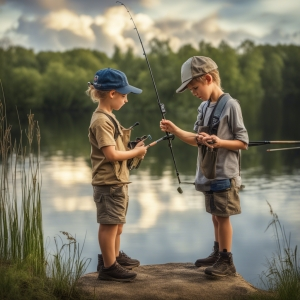Table of Contents:
Introduction: The Benefits of Introducing Kids to Fishing
Introducing kids to fishing is not just about helping them catch their first fish. It's far more than that. Fishing is an outdoor activity that offers countless benefits. It can foster a love for the environment, teach patience, and promote a sense of accomplishment. But above all, it provides an opportunity for families to spend quality time together, free from the distractions of technology.
By introducing your children to fishing at an early age, you're not only creating beautiful memories, but you're also teaching valuable skills and instilling a lifelong love for this relaxing pastime. In this article, we'll delve into some handy kids fishing tips to make their first angling experience both fun and successful.
Understanding the Basics: Fishing Equipment for Kids
Before your kid casts their first line, it's crucial they're equipped with the right fishing tackle. Kid-friendly fishing gear emphasizes more on simplicity and safety rather than complexity. For beginners, start with a simple fishing rod. It can be a short rod with a closed-face spinning reel, often coupled with bobbers and hooks which are easy to handle and child-safe.
Investing in a tackle box is also a good idea. It could include basic fishing essentials like extra hooks, weights, bobbers, and a fishing line. As the kids grow older and their fishing skills advance, you can introduce more sophisticated tackle. Remember, the goal is to create a fun, stress-free fishing experience, not to overwhelm them with complexity.
Lastly, don’t forget the importance of a life vest, especially when fishing near deep waters. Safety should always be a top priority when fishing with kids.
Pros and Cons of Introducing Kids to Angling
| Pros | Cons |
|---|---|
| Teaches patience and focus | Potential danger of hooks |
| Encourages appreciation for nature | Requires supervision and guidance |
| Builds bond between parent and child | May not capture interest of all kids |
| Promotes physical activity | Weather dependent activity |
| Provides life-long hobby | May awaken animal rights issues |
Safety First: Essential Safety Tips for Young Anglers

There is no denying that fishing is loads of fun, but it’s also essential to go over safety rules before your children start fishing. The first rule should be to always fish with an adult. Even if the water seems shallow or calm, you never know what's under the surface or when conditions might change. Patrol the fishing area for any potential hazards like slippery rocks, stinging insects, or poisonous plants.
A fishing rod is a tool, not a toy, so try to instill this understanding in your young anglers. They should learn to handle the rod with respect and consciousness, always keeping it pointed away from people. When it comes to handling hooks and baits, make sure that they understand the sharpness and the need for carefully handling it. We recommend using barbless hooks for beginners.
Don’t forget to pack a good sunscreen, hats, and sunglasses for protection from the sun. Hydrate frequently and have some nutritious snacks handy. Fishing can surprisingly drain energy with all that excitement and concentration.
Teaching the Techniques: Helpful Tips to Get Kids Started
With the right gear and safety protocols in place, it's time to move on to fishing basics. Teaching your kids how to fish involves instructing them in some fundamental techniques that will form a strong foundation for their angling journey.
Begin by demystifying the fishing rod, explaining its various components. Show them how to hold the rod properly and demonstrate the casting technique. Initial casts may not be very impressive, and that's okay! Emphasize that they will get better with practice.
Teach them how to hook a bait and explain the importance of doing it correctly. Make sure your little anglers understand the role of baits and why fish are attracted to them.
Another crucial lesson is the art of patience. Teach the kids that fish don’t come biting instantly. Fishing needs patience and calm, teaching them that often, the wait and anticipation are just as exciting as the catch itself.
Improved observation skills is another essential benefit of fishing. Explain how observing nature, understanding weather and water conditions, and being able to 'read' the water are critical skills for any successful angler.
You may also introduce them to catch and release, emphasizing respect for nature and the importance of conservation. These lessons will sow the seeds for responsible angling in the years to come.
The Joy of the Catch: Encouraging Patience and Conservation

One of the most rewarding parts of the fishing experience is the exhilaration that stems from the catch. It’s a harmonious mix of sounds, from the ‘zzzz’ of the reel to the splash of the water, that creates an unforgettable thrill. Boost that feeling of achievement and joy by celebrating your child's catch, no matter the size.
Remember though, it’s not all about the catch. Patience is a critical part of fishing. There might be times when the fish aren’t biting or the bountiful catch just seems elusive. Use these moments to develop your child’s patience. Encourage them to savor the tranquil environment and relish the act of fishing itself.
A fundamental lesson to teach your child during these fishing sessions is the importance of conservation. Make them understand the concept of sustainable fishing and why it's essential for the ecosystem. Promote catch and release, ensuring that, except for an occasional keep, most of the fish are returned unharmed, preserving the fish stock.
Highlight why it’s essential to pick litter and not to pollute the fishing area. Such hands-on education about conservation will help the younger generation grow into conscious and responsible adults.
Conclusion: Inspiring a Love of Fishing in Kids
In conclusion, introducing fishing to younger generations can instill a great sense of respect for nature, promote patience, and encourage healthy recreational habits. By keeping the sport simple and fun, children can grow to treasure those quiet days by the water. The main objective is not to catch the biggest fish but to turn each fishing experience into an opportunity for learning, discovery, and meaningful bonding.
Furthermore, introducing children to the art of fishing at an early age can instill in them the spirit of conservation. As they understand, humans are an essential part of the ecosystem, and it is upon us to ensure sustainable fishing practices.
By following these kids fishing tips, you're paving the way for the next generation of anglers who will enjoy and respect this rewarding activity. So, why wait any longer? Get out there, start casting some lines, and create precious and adventurous memories with your kids, catching fish.
FAQ: Guide to Introducing Kids to Angling

What is the right age to start teaching kids about angling or fishing?
There is no hard and fast rule, it completely depends on an individual kid's interest and concentration level. However, an ideal age to start can be around 5 to 6 years.
What type of fishing rod should children start with?
It's recommended to start with a simple, light, and short spinning rod. They are easier for children to handle.
What safety measures should be taken when kids are introduced to fishing?
Ensure life jackets are worn near water, don't allow them to use sharp equipment unsupervised, and teach them about the harmful implications of hooks and other fishing tools.
What's the best way to teach children about angling?
Start with the basics of fishing, teach them about different types of fish, how to bait, cast and finally how to handle the fish they catch. Patience is important as kids learn at their own pace.
How to make fishing engaging and fun for children?
Try to keep sessions short and fun. You can incorporate games, take food breaks and remember the main aim is to help them enjoy the outdoors and develop a lifelong love for nature.







